Michele Ciampanti (active 1463-1510) was an Italian painter active mainly in Lucca. This painter has been identified as matching Berenson's putative Master of Stratonice, and is also called Michele di Michele Ciampanti.
Contents

Michele Ciampanti (active 1463-1510) was an Italian painter active mainly in Lucca. This painter has been identified as matching Berenson's putative Master of Stratonice, and is also called Michele di Michele Ciampanti.

Biographical details about the painter were collected in the twentieth century. He seems to have either traveled to Siena or formed contacts with the work of other contemporary Tuscan painters, such as the Florentines, Filippino Lippi and Sandro Botticelli as well as the Sienese, Matteo di Giovanni and Francesco di Giorgio, although it is unclear who influenced who. [1] The cassetoni depicting the scene of Stratonice and (the son of) Antiochus (c. 1470), now at the Huntington Library in California. [2] In addition, works at the Metropolitan Museum of Art in New York, including the Cassoni of the Two Triumphs have been attributed to him. An Adoration of the Shepherds at the Galleria Cini in Venice is also attributed to this painter.


A short biography states that he was the illegitimate son, and likely pupil, of the painter Borghese di Piero Borghese, also known as the Master of the Santi Quirico e Giulitta. Documents state Michele Ciampanti was made heir of the painter in 1463, and attribute his birth to prior to 1447. He has been identified as likely a Michele da Lucca at work in 1467 in the Duomo di Pisa. The cassetoni of Stratonice and others depicting the Myth of Orpheus and Euridice and the Rape of Proserpine are attributed to a Florentine phase in the 1470s. He is said to have collaborated with Matteo Civitali and Baldassare di Biagio around 1476 in Lucca. Ciampanti is said to have painted frescoes in 1485 for the Chapel of San Regolo and in 1486 for the Ospedale di Camaiore in Lucca. He is documented alongside Vincenzo Frediano (Master of the Immaculate Conception) as pricing a work for the Oratory of San Lorenzo. His son, Ansano (Maestro di San Filippo) emerges in the late 1490s, and likely collaborated with him in some frescoes in the Baptistry of Lucca. In 1496, he painted for the tribune of the Pietrasanta Cathedral. [3]

Il Sodoma was the name given to the Italian Renaissance painter Giovanni Antonio Bazzi. Il Sodoma painted in a manner that superimposed the High Renaissance style of early 16th-century Rome onto the traditions of the provincial Sienese school; he spent the bulk of his professional life in Siena, with two periods in Rome.
The Salimbeni Prize is awarded by the Fondazione Salimbeni per le Arti Figurative of San Severino Marche to honour excellence in the writing of art history on an Italian subject. The Premio Salimbeni was established in 1983.

Domenico di Michelino (1417–1491) was an Italian Renaissance painter who was born and died in Florence. His birth name was Domenico di Francesco. The patronymic "di Michelino" was adopted in honour of his teacher, the cassone painter Michelino di Benedetto, by whom no works have been identified. Giorgio Vasari reports that Domenico was also a pupil of Fra Angelico, whose influence is reflected in many of Domenico's paintings along with that of Filippo Lippi and Pesellino.

Cecco Bravo was an Italian painter of the Florentine Baroque school. His true name was Francesco Montelatici.
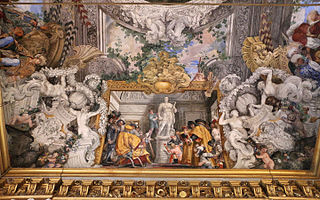
Giovanni Coli (1636–1691) was an Italian painter from Lucca, active in the Baroque style.
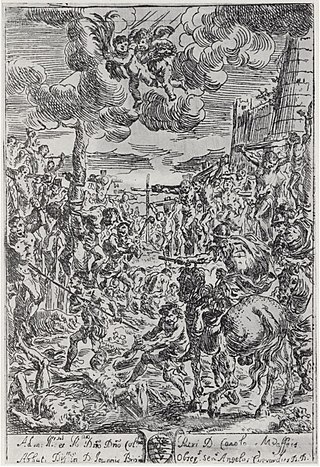
Angelo Everardi was a painter and printmaker active in Brescia in the second half of the 17th century. No paintings have been attributed to him with certainty. He is reported to have been a painter of battle scenes, Bambocciate, i.e. low life genre scenes as well as of history paintings.
The decade of the 1460s in art involved some significant events.
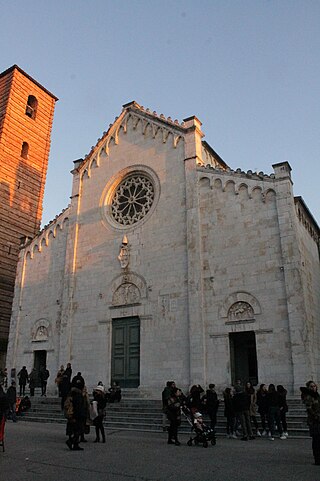
The Collegiate Church of San Martino is a collegiate church in Pietrasanta, in the region of Tuscany, Italy. It is the main church or duomo of the town. It is first mentioned in 1223, and was subsequently enlarged in 1330 and in 1387 when Pope Urban VI had a baptismal font installed in the church.

Bastiano di Bartolo Mainardi (1466–1513) was an Italian painter of the Early Renaissance. He was born in San Gimignano and was active there and in Florence.

The Isaac Master was an Italian Gothic painter active in the decoration of the Basilica of San Francesco d'Assisi in Assisi at the end of the thirteenth century. Master's name is derived from a fresco painting of the death of Isaac for which he is known, the fresco is located in the Upper Church of St Francis at Assisi, depicting Isaac blessing Jacob and Esau.

Cecco di Pietro was an Italian painter of the Pisan School. While his date of birth cannot be confirmed, there is some mention of a Cecco Pierri working with the painter Paolo di Lazzarino in 1350. If this was a reference to di Pietro, then his date of birth can be placed around 1330.
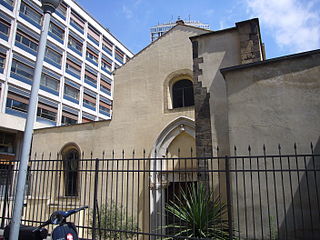
Santa Maria dell'Incoronata is an ancient church on Via Medina in Naples, Italy. It is located just south of San Giorgio dei Genovesi and across the street from the Church of Pietà dei Turchini.

The church of Santi Severino e Sossio and the annexed monastery are located on via Bartolommeo Capasso in Naples, Italy.

Giovanni Maria Ciocchi was an Italian painter and art critic, active during the Baroque period. He was born into a family of artists, and it is not clear if he is related to Giovanni Maria Ciocchi del Monte from Perugia, who became Pope Julius III. it is not clear that Giovanni Maria is related to the 16th century painter Ulisse Ciocchi.

Domenico di Zanobi, formerly known as the Master of the Johnson Nativity, was an Italian Renaissance painter. His exact dates of birth and death are not known. He is documented as a mature artist from 1467 until 1481.

The Master of Pratovecchio was an Italian painter of the Renaissance, named by Roberto Longhi in a 1952 article on the basis of stylistic similarities of a number of works to an altarpiece painted for the monastery of San Giovanni Evangelista in Pratovecchio. The centre panel of the triptych, depicting the Assumption of the Virgin is currently on deposit in Arrezo; the left and right side-panels are in the National Gallery, London.

Baldassarre di Biagio, also called Baldassarre di Biagio del Firenze or the Master of the Benabbio Triptych, (1430/1434–1484) was an Italian painter of the high Renaissance period.

Vincenzo Rustici was an Italian painter active in Siena. He was known for his religious compositions as well as his vedute showing public celebrations in Siena.
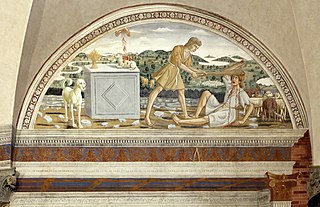
Bernardo di Stefano Rosselli (1450–1526) was an Italian painter active in his native Florence and the surrounding countryside.

Minerva between Geometry and Arithmetic is a fresco fragment, usually attributed to Paolo Veronese, from 1550, but by some art historians to Anselmo Canera or Giambattista Zelotti. It was painted for the Palazzo de Soranzi in Castelfranco Veneto but is now in the Palazzo Balbi, in Venice.